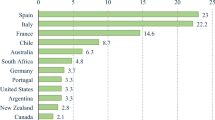Abstract
The evaluation of wine quality is multifactorial and involves scoring characteristics that relate to a wine’s appearance, aroma and taste. These scores are, at least in part, subjective to individual expertise, experience and interpretation. Given this constraint, it is not surprising that the development of an objective, scientifically-based system for quantitatively scoring wine has remained elusive. In this work, multiple classification-based systems for predicting wine quality based on a set of measured physicochemical properties in the final product are evaluated. Several data pre-processing techniques are employed including, z-score normalization, outlier reduction, and principal component analysis (PCA). The resulting transformed data is then applied to various machine learning models (i.e., Multilayer Neural Networks (MNN), Random Forest (RF), basic Decision Tree (DT) and Support Vector Machines (SVM)). Standard metrics (i.e., confusion matrix, classification accuracies, precision, recall, F1-score), are compared for each model. A comparison of the results obtained in this study to contemporary works using similar metrics shows that two of the classifiers used in the current study (i.e., MNN with Adam optimizer and Random Forest) performed with higher classification accuracies and precision (70%/73 and 72%/73, respectively).
Access this chapter
Tax calculation will be finalised at checkout
Purchases are for personal use only
Similar content being viewed by others
References
Hopfer, H., Nelson, J., Ebeler, S., Heymann, H.: Correlating wine quality indicators to chemical and sensory measurements. Molecules 20 8453–8483 (2015). https://www.mdpi.com/1420-3049/20/5/8453/pdf. Accessed 8 Oct 2018
Cortez, P., Cerdeira, A., Almeida, F., Matos, T., Reis, J.: Modeling wine preferences by data mining from physicochemical properties. Decis. Support Syst. 47, 553–574 (2009). https://www.stat.auckland.ac.nz/~stats330/datasets.dir/cortez2009.pdf. Accessed 8 Oct 2018
Appalasamy, P., Mustapha, A., Rizal, N.D., Johari, F., Mansor, A.F.: Classification-based data mining approach for quality control in wine production. J. Appl. Sci. 12, 598–601 (2012). https://scialert.net/abstract/?doi=jas.2012.598.601. Accessed 8 Oct 2018
Ebeler, S.: Linking flavour chemistry to sensory analysis of wine. In: Flavor Chemistry — Thirty Years of Progress, Kluwer Academic Publishers, pp. 409–422 (1999)
UCI Machine Learning Repository. http://archive.ics.uci.edu/ml/datasets/Wine+Quality. Accessed 12 Oct 2018
Muller, A.C., Guido, S.: Introduction to Machine Learning with Python, pp. 85–88. O’Reilly Media, Sebastopol (2017)
Anaconda Software Distribution: Computer software. Vers. 2-2.4.0. Anaconda, November 2016. https://anaconda.com. Accessed 12 Oct 2018
Alpaydin, E.: Introduction to Machine Learning. Massachusetts Institute of Technology, Cambridge (2014)
Raschka, S.: Python Machine Learning, pp. 128–138. Packt Publishing, Birmingham (2015)
Lever, M., Krzywinski, N.A.: Principal component analysis. Nat. Methods 14, 641–642 (2017). State Statistical Software (2010). [Computer Software]., Nature Publishing Group, a division of Macmillan Publishers Limited. June 28th
Keras. https://keras.io/. Accessed 12 Oct 2018
Cortez, P., Teixeira, J., Cerdeira, A., Almeida, F., Matos, T., Reis, J.: Using data mining for wine quality assessment. In: Gama, J., Costa, V.S., Jorge, A.M., Brazdil, P.B. (eds.) Discovery Science. DS 2009. LNCS, vol. 5808. Springer, Heidelberg (2009)
Hu, G., Xi, T., Mohammed, F., Miao, H.: Classification of wine quality with imbalanced data. In: IEEE International Conference on Industrial Technology (ICIT), pp. 1217–1712 (2016)
Er, Y., Atasoy. A.: The classification of white wine and red wine according to their physicochemical qualities. Int. J. Intell. Syst. Appl. Eng. 23–23 (2016). https://doi.org/10.18201/ijisae.265954
Gupta, Y.: Selection of important features and predicting wine quality using machine learning techniques. Procedia Comput. Sci. 125(2018), 305–312 (2017)
Aich, S., Al-Absi, A., Hui, K., Sain, M.: Prediction of quality for different type of wine based on different feature sets using supervisor machine learning techniques. Trans. Adv. Commun. Technol. (TACT) 7(3), 1122–1127 (2018). https://doi.org/10.23919/icact2019.8702017
Aich, S., Sain, M., Yoon, J.-H.: Prediction of Different Types of Wine Using Nonlinear and Probabilistic Classifiers. In: Krishna, A.N., Srikantaiah, K.C., Naveena, C. (eds.) Integrated Intelligent Computing, Communication and Security. SCI, vol. 771, pp. 11–19. Springer, Singapore (2019). https://doi.org/10.1007/978-981-10-8797-4_2
Chawla, N., Bowyer, K., Hall, L., Kegelmeyer, W.: SMOTE: Synthetic Minority Over-sampling Technique. J. Artif. Intell. Res. 16, 321–357 (2002)
UCI. https://archive.ics.uci.edu/ml/datasets/Wine. Accessed 13 Jan 2018
Author information
Authors and Affiliations
Corresponding author
Editor information
Editors and Affiliations
Rights and permissions
Copyright information
© 2020 Springer Nature Switzerland AG
About this paper
Cite this paper
Laughter, A., Omari, S. (2020). A Study of Modeling Techniques for Prediction of Wine Quality. In: Arai, K., Kapoor, S., Bhatia, R. (eds) Intelligent Computing. SAI 2020. Advances in Intelligent Systems and Computing, vol 1228. Springer, Cham. https://doi.org/10.1007/978-3-030-52249-0_27
Download citation
DOI: https://doi.org/10.1007/978-3-030-52249-0_27
Published:
Publisher Name: Springer, Cham
Print ISBN: 978-3-030-52248-3
Online ISBN: 978-3-030-52249-0
eBook Packages: Intelligent Technologies and RoboticsIntelligent Technologies and Robotics (R0)




